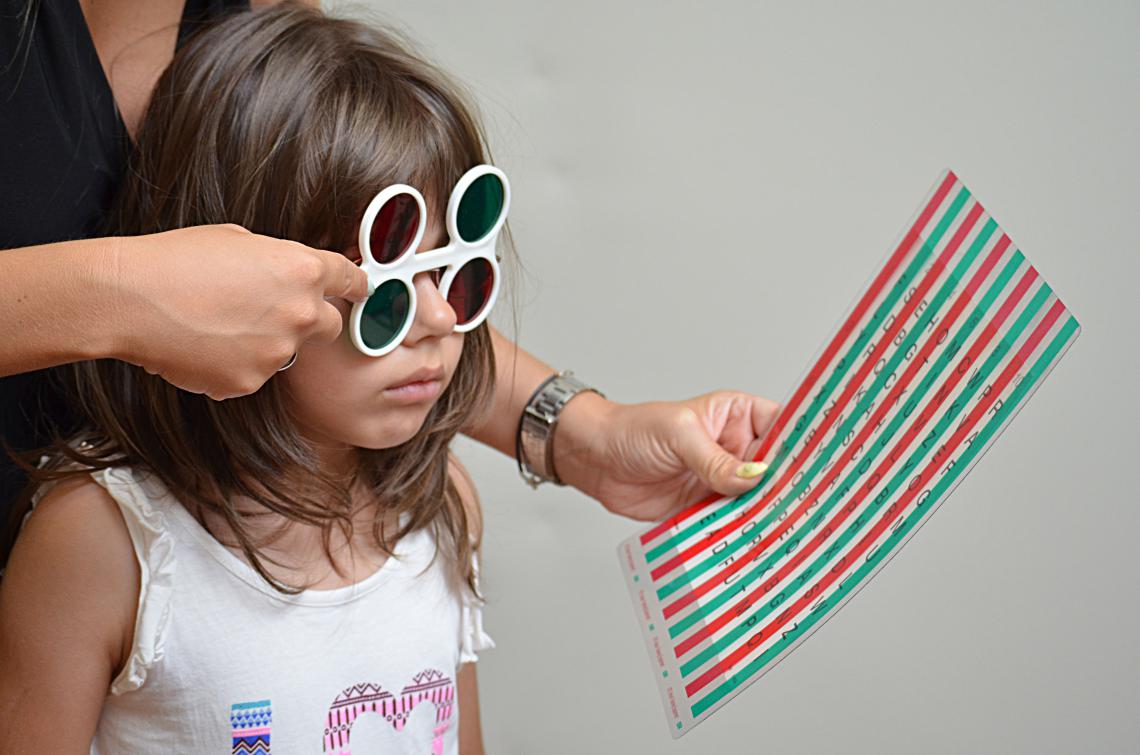What is Strabismic Amblyopia?

Strabismus is the most common cause of amblyopia. To avoid double vision caused by poorly aligned eyes, the brain ignores the visual input from the misaligned eye, leading to amblyopia in that eye (the "lazy eye"). This type of amblyopia is called strabismic amblyopia.
Strabismus is a deviation of one eye with loss of eye parallelism. As a result, the eyes do not receive equal images, leading the visual system to adapt to this change.
When the visual system is completely formed (when the person reaches adulthood), the perception of non-corresponding images by 2 eyes leads to double vision, but when the visual system is in its critical period of development (in childhood), the brain is still capable of using mechanisms to avoid diplopia or rivalry by inhibiting the activation of the retinocortical pathways originating from the fovea of the deviating eye. This adaptive mechanism avoids diplopia, but it causes a restructuring of the visual cortical circuits in the visual cortex that in turn causes amblyopia.
In strabismic amblyopia, the cortical ocular dominance columns remain structured, even in cases of moderate amblyopia. Only in cases of deep amblyopia are there reports of alteration of dominance columns.
Although the cortical cellular apparatus is relatively preserved, many functional changes occur in the visual system. There is active and deep suppression of the dominant eye over the deviating eye, retinal correspondence is completely lost, and cellular interactions are altered.
Tychesen and colleagues have shown many visual function alterations in monkeys with strabismus, as well as loss of V1 binocular connections. The severity of motor ocular changes and the loss of V1 binocular connections increased as a function of the duration of decorrelation. The animals exposed to only 3 weeks of decorrelation recovered these functions. Other studies have shown that excitatory interactions for the deviating eye remain deactivated, but inhibitory ones do not, even after correction of the position of the deviating eye, indicating active cortical suppression and an imbalance between the cortical cellular columns.
Strabismus causes change in or loss of connectivity to the cortical spatial information pathways, altering the spatial summation and side inhibitions of received stimuli and, consequently, preventing the integration of contours and shapes. A distortion of the spatial vision occurs that interferes with numerous discriminatory visual tasks including visual acuity, Vernier visual acuity (alignment accuracy), and crowding.
In strabismus there is no binocular facilitation for any type of stimulus; the suppression is constant and strong and is probably a modified form of suppression of binocular rivalry. Suppression is also found in the fovea of the normal eye when the amblyopic eye is fixing, showing that lost visual acuity is not related solely to suppression. Thus, it is suppression that leads to amblyopia in an individual who has strabismus and not vice versa, because the inactivity of the system may interfere with the process of synaptic development.
In strabismus, the different stimuli received by the eyes prevent normal image fusion, compromising binocular vision and summation and the ability to discriminate disparity and depth of vision with altered stereoscopic visual acuity (stereopsis) and even postural stability.
Contrast sensitivity in strabismic amblyopia is less affected than in amblyopia due to deprivation or anisometropia, with change mainly to high spatial frequencies.
Amblyopia caused by strabismus therefore has a major impact on visual acuity and binocular vision, and contrast sensitivity is relatively sparing.
Signs and Symptoms of Strabismic Amblyopia
People with Strabismic Amblyopia will often experience:
- Poor depth perception
- Difficulty catching and throwing objects
- Clumsiness
- Squinting or shutting an eye
- Head turn or tilt
- Eye strain
- Fatigue with near work
It is important to note that a young child with amblyopia rarely expresses any symptoms or knows that what they are experiencing isn't normal.
If you notice your baby or young child has crossed eyes or some other apparent eye misalignment, schedule an appointment with an eye doctor near you immediately — preferably with an optometrist or ophthalmologist who specializes in children's vision.
Treatment of Strabismic Amblyopia
Improvements are possible at any age, but early detection and treatment offer the best outcome. Even if no signs or symptoms are noticed, it is important that children are taken to an optometrist for a comprehensive visual assessment during the first year of life to help catch problems like amblyopia at an early stage.
Treatment of strabismic amblyopia can include vision therapy, eye patching, eye drops, strabismus surgery to straighten the eyes, or a combination of those options. Treatment may also include the use of prescription lenses. Many people try non-surgical options first before resorting to surgery. Virtual Reality activities are part of vision therapy program options for patients with strabismic amblyopia.
When amblyopia is suspected, an initial clinical examination should include visual acuity testing, fixation, refraction, evaluation of ocular alignment and sensory fusion, stereoacuity, accommodation, ocular motility and a thorough ocular health evaluation. Acuity testing can be particularly challenging in amblyopic patients: they generally perform poorly on full chart acuity, but exhibit better results on single-line and single-letter acuity testing due to the crowding phenomenon. It is important, therefore, to use the same type of visual acuity testing on follow up examination to avoid obtaining an artificially high or low visual acuity measurement. It can be difficult to test young children using full-line visual acuity, but using isolated letters may not adequately describe the vision loss seen in amblyopia.
The Amblyopia Treatment Studies use a single HOTV (for children ages three to under seven) or ETDRS (for children ages seven and older) optotype surrounded by crowding bars to evaluate visual acuity, which combines the ease of testing using single letter acuity with the addition of a consistent contour surrounding each letter. Obtaining both single-line and single-letter visual acuity measurements give an estimate of the impact of crowding on the decrease in visual acuity in amblyopic patients.
An objective, and if possible a subjective, evaluation of refractive error should be performed during all initial examinations of patients with amblyopia, both before and after cycloplegia. Two drops of cyclopentolate 1% are used in children over the age of one for cycloplegic retinoscopy and refraction. If the patient also needs a dilated fundus evaluation, mydriatic drops should be used in addition to cyclopentolate to give adequate mydriasis for a peripheral retinal examination. Subjective refraction can be challenging in patients with amblyopia, and it is important to have a good objective measure of refractive error, such as retinoscopy. When prescribing for patients with amblyopia, take into consideration the refractive error before and after cycloplegia, the amount of anisometropia after cycloplegia and the patient’s ocular alignment.
A careful evaluation of ocular alignment is necessary to determine the presence or absence of strabismus, and sensory fusion can be evaluated using random dot stereoacuity and Worth 4-Dot testing. An evaluation of fixation using a visuoscope target should also be done in all patients with amblyopia to evaluate for the presence or absence of eccentric fixation. Finally, a thorough ocular health evaluation is critical for proper diagnosis. Any pathological cause of decreased visual acuity must be ruled out prior to making a diagnosis of amblyopia. Patients with amblyogenic conditions such as strabismus or significant refractive error may also concurrently have an ocular disease process occurring, which may contribute to the decrease in visual acuity.
You can find a vision therapy specialist near you!

Reference
https://www.aao.org/disease-review/amblyopia-types-diagnosis-treatment-new-perspectiv
The Vision Wiki
- Lazy Eye
- History of Lazy Eye
- Convergence Disorders
- Convergence Insufficiency
- Exophoria
- Esophoria
- Medical Terms
- Accommodation Disorders
- Accommodative Esotropia
- Accommodative Insufficiency
- Amblyopia
- Lazy Eye in Adults
- Strabismic Amblyopia
- Refractive Amblyopia
- Anisometropia
- Critical Period
- Strabismus
- Anomalous Retinal Correspondence
- Transient Strabismus
- Exotropia
- Esotropia
- Hypotropia
- Hypertropia
- Eye Problems
- Binocular Vision
- Physiology of Vision
- Lazy Eye Treatments
- Reading
- Fields of Study
- Research
- Glaucoma
- Virtual Reality
- Organizations
